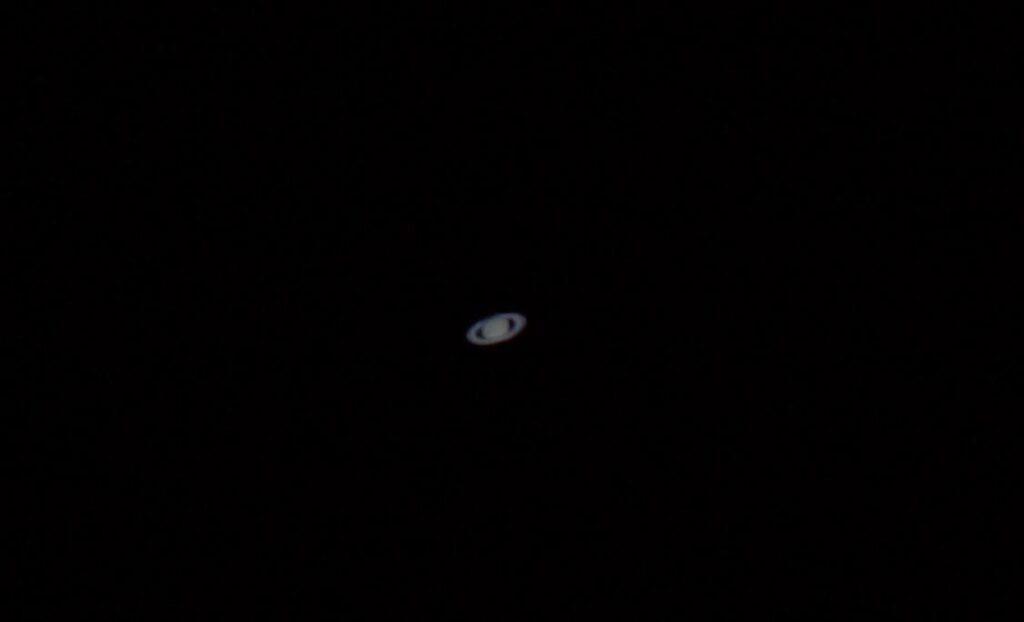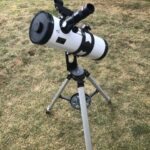Magnification is an important part of astronomy, but perhaps not as important as you think.
Telescopes are magnifying instruments, so beginners tend to make this one of the top criteria when shopping for a telescope. But high magnification, say upwards of 300x, is only useful on certain objects, and under the right conditions.

A typical view of Saturn through a small telescope. Increasing magnification will often make detail harder to spot.
In theory, you can expect to get up to 50x of usable magnification per inch of telescope aperture. But reality is more complicated, since atmospheric conditions and other factors can limit usable magnification to 200x or less no matter how large your aperture is.
In this article we’ll discuss the role of magnification, how much magnification you can expect from your telescope, and how much you should realistically aim for.
How Magnification Works
Every telescope has a native focal length, defined by the distance from the objective to the focal plane. The focal length provides a sort of “baseline magnification”, with longer focal length providing more magnification. This is the difference between a wide-angle and telephoto camera lens.
In photography, the image is projected directly onto the camera sensor (or film, if you’re old school). With a telescope, we use eyepieces to further magnify the image for viewing, and these work in the opposite direction: an eyepiece with a short focal length provides higher magnification than a long one, via this formula:
Magnification=Telescope focal length/eyepiece focal length.
Magnification increases the angular size of objects while decreasing the true field of view in equal proportion. So, an object will appear twice as large at 50x as at 25x, but the space around the object will decrease by half.
Overall image brightness also decreases as magnification increases.
What is Your Highest Useful Magnification?
To figure out your maximum theoretical magnification, you can multiply your telescope aperture in inches by 50, or in millimeters by 2, which gives an exit pupil of 0.5mm. (For more on exit pupils, read this).
Keep in mind that usable magnification might be closer to 25x per inch.
But why are there limits on magnification in the first place? There are a few reasons:
Telescope Aperture
Both the light-gathering ability and the resolution of your telescope are directly related to its aperture.
When a small telescope is pushed to high magnifications, you can exceed its capabilities in both these departments, leading to views which are dim and blurry. Yes, the object will appear larger as you increase magnification, but beyond a certain point the increased size will not be worth the loss of clarity.
Use the 50x per inch figure as a guideline. Sometimes you may squeeze more magnification out of your scope, but often it will be less.
Atmospheric Seeing
Even with a large telescope, you may not be able to reach the theoretical maximum magnification very often due to poor seeing which creates a distorted image.
Seeing can be affected by unstable air in the upper atmosphere, heat rising from nearby surfaces such as rooftops, or other local conditions.
Depending on where you live, you may only get a few nights of good seeing per year! For this reason, many amateur astronomers seldom go beyond 200x magnification, even with a large telescope.
Telescope Quality and Collimation
It is often the case that a small telescope can achieve higher magnification than a larger one, if the optics are of better quality and are better aligned. A poorly-assembled 3-inch refractor is going to struggle to reach 150x, while an 8-inch reflector which is out of collimation will face similar problems.
Quality and Type of Mount
A stable tripod and a mount head with smooth motions are both essential to high-power viewing. Most beginner-quality mounts are too wobbly to be useful above 100x or so.
If the mount is prone to slipping out of position, you will lose your target easily.
Even a decent-quality mount can be a challenge at high power if it lacks automatic tracking or slow-motion controls.
Even with all of these considerations, it is worth it to have the ability to use high magnification when the conditions and equipment can handle it.
When to Use High Magnification
If you have an aperture of at least 150mm, good collimation, and steady seeing, here are some situations when high magnification would be beneficial.
- Splitting close double stars.
- Resolving fine detail on Jupiter or Mars.
- Observing small planetary nebulae.

The Cat’s Eye nebula is an object where I have exceeded the 50x per inch limit with some success.
- Glimpsing small details in emission nebulae.
Which Eyepiece Should You Get for High Magnification?
Eyepieces are one way to increase your magnification. When you are building your eyepiece collection be sure you are getting the right tools for your setup.
There are a few things you need to consider here:
Focal Length
This will depend on your telescope: Remember that magnification is function of the focal length of both your telescope and your eyepiece.
An eyepiece which provides the full 50x per inch of aperture may not get much use.
A better idea might be to buy an eyepiece which yields 20-25x per inch, and get a 2x barlow lens to employ on the steadiest nights.
Apparent Field of View (AFOV)
If you have a manually-driven telescope, it is a good idea to spend a bit more to get a wide AFOV (70-80 degrees) for your high-powered eyepiece. This will allow you to observe objects for longer before they drift out of view.
This is somewhat less important if your telescope has auto tracking.
Eye Relief
Eyepieces supplied with beginner telescopes often have short eye relief, particularly at short focal lengths. Eye relief is a personal preference, but I find a high-powered view to be more immersive with a comfortable eye relief of over 15mm.
Beware False Magnification Claims!
One thing I can hardly stress enough is that you should never buy a telescope based on magnification claims.
In fact, we can go a step further and say you should never buy a telescope which advertises magnification as a selling point at all.
Consider magnification, but it is not at all as important as focal length, aperture, and quality.
The majority of low quality telescopes greatly exaggerate the instrument’s magnification capabilities to entice you to buy.
How do they get away with it? Simple: they include accessories such as a 4mm eyepiece and 5x barlow lens, which will mathematically produce some ridiculously high magnification. But they neglect to tell you that these accessories are worthless and the telescope can’t function in such a way.
You are left to find this out for yourself when you try to aim or focus the telescope with these accessories, only to find it is impossible. This is one of the main reasons we call such instruments “hobby killers”.
Maximum magnification should be listed in the product specifications. The spec sheet might also indicate the magnifications provided by the included eyepieces. But if a high magnification figure appears in bold letters on the front of the box, stay away.





